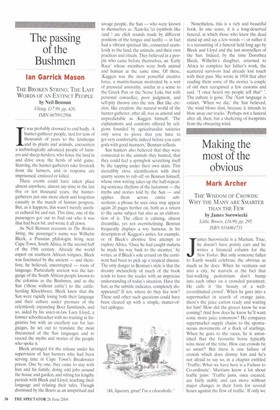The passing of the Bushmen
Ian Garrick Mason
THE BROKEN STRING: THE LAST WORDS OF AN EXTINCT PEOPLE by Neil Bennun Viking, £17.99, pp. 420, ISBN 0670912506 It was probably doomed to end badly. A hunter-gatherer people, tied for tens of thousands of years to the landscape and its plants and animals, encounters a technologically advanced people of farmers and sheep-herders, who fence the land in and drive away the herds of wild game. Starving, the hunter-gatherers take livestock from the farmers, and in response are imprisoned, enslaved or killed.
These events could have taken place almost anywhere. almost any time in the last five or ten thousand years, the huntergatherers just one more silent and forgotten casualty in the march of human progress. But, as it happens, this wasn't merely another cultural hit and run. This time, one of the passengers got out to find out who it was that had been hit, and wrote it all down.
As Neil Bennun recounts in The Broken String, the passenger's name was Wilhelm Bleek, a Prussian philologist living near Cape Town, South Africa, in the second half of the 19th century. Already the world expert on southern African tongues, Bleek was fascinated by the ancient — and therefore, he believed, uncorrupted — roots of language. Particularly ancient was the language of the South African people known to the colonists as the Bushmen, and as the San ('those without cattle') to the cattleherding IChoekhoen. Bleek knew that the San were rapidly losing both their language and their culture under pressure of the relentlessly expanding Boer farmlands, and so, aided by his sister-in-law Lucy Lloyd, a former schoolteacher with no training in linguistics but with an excellent ear for languages, he set out to translate the most threatened of the San languages and to record the myths and stories of the people who spoke it.
Bleek arranged for the release under his supervision of San hunters who had been serving time in Cape Town's Breakwater prison. One by one, they came to stay with him and his family, doing odd jobs around the house and garden, and sitting for lengthy periods with Bleek and Lloyd, teaching their language and relating their tales. Though dismissed by the Boers as an unspiritual and
savage people, the San — who were known to themselves as /Xamka !ei (symbols like /and ! are click sounds made by different positions of the tongue and teeth) — in fact had a vibrant spiritual life, connected seamlessly to the land, the animals, and their own practices and rituals. They believed in a people who came before themselves, an 'Early Race' whose members were both animal and human at the same time. Of these, /Kaggen was the most powerful creative force, a mantis-human motivated by a sort of presocial amorality, similar in a sense to the Greek Pan or the Norse Loki, but with personal cowardice, poor judgment, and self-pity thrown into the mix, But like creator, like creation: the natural world of the hunter-gatherer, after all, was as amoral and unpredictable as /Kaggen himself. 'The explanations and comforts offered by religions founded by agriculturalist societies only serve to prove that you have to get very comfortable indeed before you earn gods with good manners,' Bennun reflects.
San hunters also believed that they were connected to the animals they hunted, that they could feel a springbok scratching itself by the tapping under their own skins, This incredibly close identification with their quarry seems to rub off on Bennun himself, whose own writing takes up the half-repeating sentence rhythms of the kukummi — the myths and stories told by the San — and applies them across entire subsections: a phrase he uses once may appear again 20 pages further on, both as a return to the same subject but also as an elaboration of it, The effect is calming, almost dreamlike, yet not overwhelming. Bennun frequently displays a wry humour, in his description of /Kaggen's antics, for example, or of Bleek's abortive first attempt to explore Africa. 'Once he had caught malaria he made his way back to the steamer,' he writes, as if Bleek's sole errand on the continent had been to pick up a tropical disease. The only danger in Ben nun's style is that the dreamy melancholy of much of the book tends to leave the reader with an imprecise understanding of today's situation. Have the San, as the subtitle indicates, completely disappeared? If not, where do they live now? These and other such questions could have been cleared up with a simple, matter-offact epilogue.
Nonetheless, this is a rich and beautiful book. In one sense, it is a long-deserved funeral, at which those who knew the dead stand up and say a few words — or rather it is a recounting of a funeral held long ago by Bleek and Lloyd and the last storytellers of the San. Indeed, by the time Dorothea Bleek, Wilhelm's daughter, returned to Africa to complete her father's work, the scattered survivors had already lost touch with their past. She wrote in 1910 that after reading them some of the stories 'a couple of old men recognised a few customs and said, "I once heard my people tell that" '. The culture is gone. The /Xam language is extinct. 'When we die,' the San believed, 'the wind blows dust, because it intends to blow away our tracks,' Perhaps not a funeral after all, then, but a sheltering of footprints from the obscuring wind.


































































 Previous page
Previous page